Of all the strokes that we use in canoeing, the forward stroke is probably the most important. But the next most important stroke is the stern pry.
An incorrect stern pry is like driving with your brakes on. Unlike other strokes, the stern pry is either done right or dead wrong. There is no gray area. That is why it gets so much bad press. People do what they think is a stern pry and obtain a negative result, so they abandon the stroke. Instead of working on their stern pry to do it right, they substitute other strokes that will do what they want, but not as well as the stern pry.
Done correctly, the stern pry is a powerful, effective, and efficient stroke. Here are the key points to a well-executed stern pry:
- Connect the stern pry to a forward stroke whenever possible. At the end of the power phase of the forward stroke, feather the blade at the knee and slice the blade back to the stern pry catch position. (See forward stroke.)
- Start the stern pry (catch position) with your:
- Shoulders rotated parallel with the gunnel, so you face the stroke.
- Shaft hand on the gunnel 6 to 8 inches behind the hip.
- Shaft arm bent.
- Grip arm nearly straight and at a right angle to the keel line -- your grip hand pushed out over the water -- so that the paddle shaft is parallel to the keel line.
- Grip hand elevated enough to have the entire blade down in the water
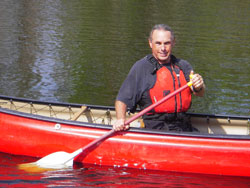
Good catch position, shaft hand 6-8” behind hip, shaft arm bent, both hands over the water, blade vertical.
|
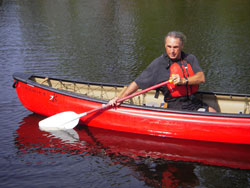
Poor position, shaft hand is to far back and arm is straight. This is hard on the shoulder joint and a weak body position.
|
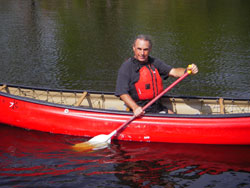
This is probably the biggest mistake on the catch position, doing it at the hip. Really kills hull speed and doesn’t correct the boat. |
- Execute the stroke (“power” phase) by:
- Holding the shaft hand still (it does not move off of the gunnel).
- Quickly pulling the grip hand in no more than 4 to 6 inches. Pull straight across, not across and downwards. Any downward pull will have a tendency to drive the gunnel down and to tip the boat.
- Execution should take only about a millisecond. The stern pry is a “Pop” – a fast pry off the gunnel. It is not a slow or lingering stroke like a rudder.
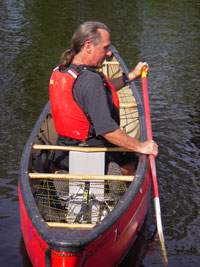
Good ending power position. This is about where the stroke should end. |
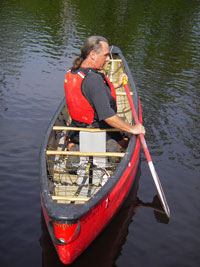
Marginal ending power position. Have pulled in with the top hand too far. |
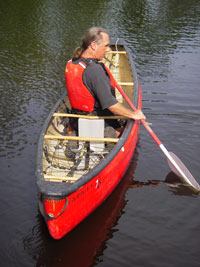
Poor ending power position. This is a goon stroke, slows the boat, have pulled on the top way too far. |
- End the stroke (recovery) by:
- Immediately after the “Pop” is finished, take the blade out of the water.
- If more correction is needed, execute another Pop. Do not make the first stroke longer, as the longer the stern pry, the more you will push the blade out from the hull, and the more that you kill your speed. Two quick, correct stern pries are better than one long stern pry.
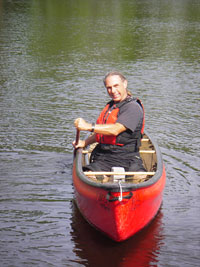
Good |
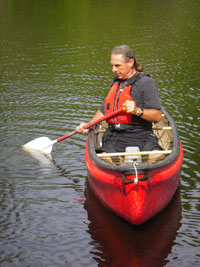
Poor, stroke is too long |
As you can see, there are a number of key points that do not come naturally, and – if any of these key points are not done well – the stern pry becomes a negative stroke. When it is done incorrectly, it has been called the Goon stroke for good reason.
Points or areas to look at if your stern pry is not working:
- Are you pushing out from the gunnel with your shaft hand instead of prying off the hull? If so, you are doing a push-away stroke instead of a pry. Your shaft hand stays on the gunnel and the pry is off the hull.
- Are you starting the stroke with the shaft hand near the hip, not 6 to 8 inches behind the hip? Executing the pry at your hip will push the whole boat sideways and kill hull speed. You are trying to move the stern and maintain hull speed.
- Are you are starting the stroke without getting your paddle shaft in line with the keel? If so, your grip hand at the start of the stroke is not out over the water but inside over the boat. This means you’re starting with the blade out at an angle from the hull (not parallel with the hull), which slows the boat.
- Are you pulling your grip hand in too far? The natural tendency is to pull until the top hand is in the center of the boat or across the chest. This pulls the blade out to about a 45 degree angle from the boat – which really kills hull speed. Pull in just 4 to 6 inches.
- Are you taking a second or more to execute the stroke? If so, you are turning the stroke into a rudder-type stroke – which also kills hull speed.
- Are you pulling down with your grip hand instead of pulling only across? If so, you may be causing the gunnel to dip during the stroke – which can be unnerving.
If you have a great stern pry linked to your forward stroke, you will be able to abandon the slower and weaker cross-forward stroke that you have been using for correction. Compared to the cross-forward stroke, the forward stroke and stern pry combination is stronger and takes far less time than the forward stroke and cross-forward stroke combination, as there is no crossing of the paddle over the hull and back again involved. Moreover, the forward stroke and stern pry combination keeps the blade in the water more. Learn to execute a stern pry correctly and you will stay on surf waves better, complete offside ferries with ease, and go to places that previously were out of reach.
|

